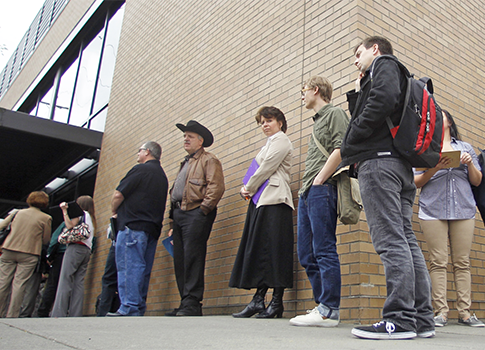The number of Americans not participating in the labor force declined to 94,366,000 in January, according to the latest numbers released by the Bureau of Labor Statistics.
More Americans joined the labor force this month, leading to an uptick in the labor force participation rate and a decline in the number of Americans who are out of the labor force.
The number of Americans not in the labor force hit a record-high of 95,102,000 in December. This month, that number declined by 736,000 individuals.
The bureau counts those not in the labor force as people who do not have a job and did not actively seek one in the past four weeks.
The labor force participation rate, which is the percentage of the population that has a job or actively looked for one in the past month, increased from 62.7 percent in December to 62.9 percent in January.
While more joined the labor force this month, the number of unemployed individuals increased by 106,000 Americans, leading to an increase in the unemployment rate.
The unemployment rate for all Americans increased from 4.7 percent in December to 4.8 percent in January. This measure does not account for those individuals who have dropped out of the labor force and simply measures the percent of those who did not have a job but actively sought one over the month.
The "real" unemployment rate, otherwise known as the U-6 measure, was 9.4 percent in January, which increased from 9.2 percent in the previous month.
There were 5,840,000 Americans working part-time in January who would rather have a full-time job but cited economic reasons for not having such employment. This number increased by 242,000 over the month.
According to the bureau, involuntary part-time workers are "persons who indicated that they would like to work full time but were working part time (1 to 34 hours) because of an economic reason, such as their hours were cut back or they were unable to find full-time jobs."
"It looks like the optimism of the last two months is boosting the demand for workers," said Juanita Duggan, president and CEO of the National Federation of Independent Business. "That's a great thing for Americans looking for jobs and a strong sign that the U.S. economy is heating up."
"Fifteen percent of small business owners said that finding qualified workers was their single biggest problem," said Bill Dunkelberg, chief economist at the association. "That's an increase from the previous month and more proof that the labor market is getting tighter."
"In a tight labor market, business owners have to raise compensation to attract and retain the employees they need," he said. "The competition for qualified workers is getting more intense, and I would expect that in the next few quarters more firms will try to increase prices to cover the higher cost of labor."
